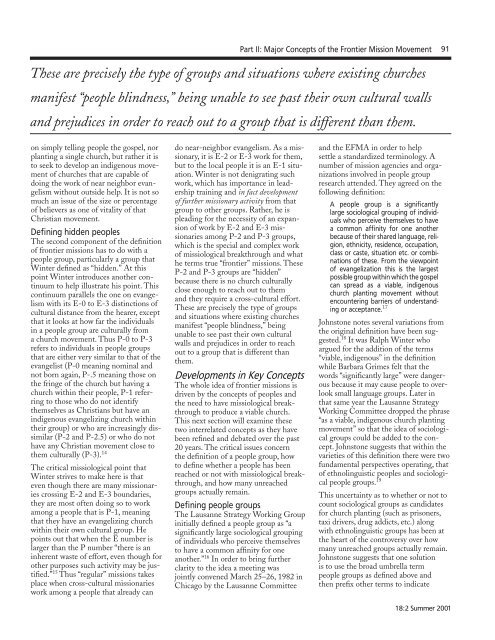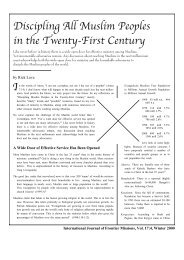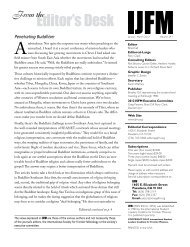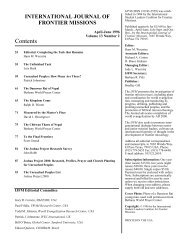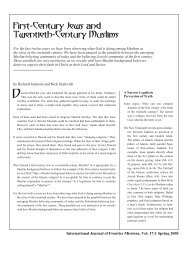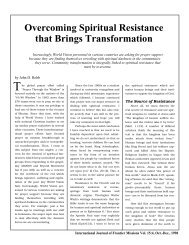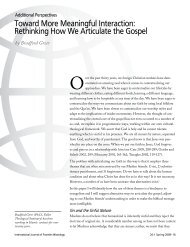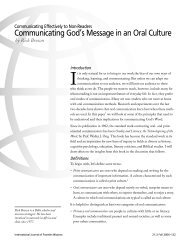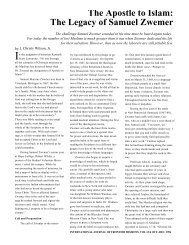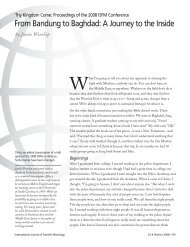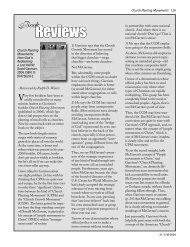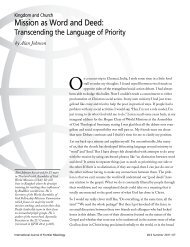Volume 18:2 - International Journal of Frontier Missions
Volume 18:2 - International Journal of Frontier Missions
Volume 18:2 - International Journal of Frontier Missions
Create successful ePaper yourself
Turn your PDF publications into a flip-book with our unique Google optimized e-Paper software.
Part II: Major Concepts <strong>of</strong> the <strong>Frontier</strong> Mission Movement<br />
91<br />
These are precisely the type <strong>of</strong> groups and situations where existing churches<br />
manifest “people blindness,” being unable to see past their own cultural walls<br />
and prejudices in order to reach out to a group that is different than them.<br />
on simply telling people the gospel, nor<br />
planting a single church, but rather it is<br />
to seek to develop an indigenous movement<br />
<strong>of</strong> churches that are capable <strong>of</strong><br />
doing the work <strong>of</strong> near neighbor evangelism<br />
without outside help. It is not so<br />
much an issue <strong>of</strong> the size or percentage<br />
<strong>of</strong> believers as one <strong>of</strong> vitality <strong>of</strong> that<br />
Christian movement.<br />
Defining hidden peoples<br />
The second component <strong>of</strong> the definition<br />
<strong>of</strong> frontier missions has to do with a<br />
people group, particularly a group that<br />
Winter defined as “hidden.” At this<br />
point Winter introduces another continuum<br />
to help illustrate his point. This<br />
continuum parallels the one on evangelism<br />
with its E-0 to E-3 distinctions <strong>of</strong><br />
cultural distance from the hearer, except<br />
that it looks at how far the individuals<br />
in a people group are culturally from<br />
a church movement. Thus P-0 to P-3<br />
refers to individuals in people groups<br />
that are either very similar to that <strong>of</strong> the<br />
evangelist (P-0 meaning nominal and<br />
not born again, P-.5 meaning those on<br />
the fringe <strong>of</strong> the church but having a<br />
church within their people, P-1 referring<br />
to those who do not identify<br />
themselves as Christians but have an<br />
indigenous evangelizing church within<br />
their group) or who are increasingly dissimilar<br />
(P-2 and P-2.5) or who do not<br />
have any Christian movement close to<br />
them culturally (P-3). 14<br />
The critical missiological point that<br />
Winter strives to make here is that<br />
even though there are many missionaries<br />
crossing E-2 and E-3 boundaries,<br />
they are most <strong>of</strong>ten doing so to work<br />
among a people that is P-1, meaning<br />
that they have an evangelizing church<br />
within their own cultural group. He<br />
points out that when the E number is<br />
larger than the P number “there is an<br />
inherent waste <strong>of</strong> effort, even though for<br />
other purposes such activity may be justified.”<br />
15 Thus “regular” missions takes<br />
place when cross-cultural missionaries<br />
work among a people that already can<br />
do near-neighbor evangelism. As a missionary,<br />
it is E-2 or E-3 work for them,<br />
but to the local people it is an E-1 situation.<br />
Winter is not denigrating such<br />
work, which has importance in leadership<br />
training and in fact development<br />
<strong>of</strong> further missionary activity from that<br />
group to other groups. Rather, he is<br />
pleading for the necessity <strong>of</strong> an expansion<br />
<strong>of</strong> work by E-2 and E-3 missionaries<br />
among P-2 and P-3 groups,<br />
which is the special and complex work<br />
<strong>of</strong> missiological breakthrough and what<br />
he terms true “frontier” missions. These<br />
P-2 and P-3 groups are “hidden”<br />
because there is no church culturally<br />
close enough to reach out to them<br />
and they require a cross-cultural effort.<br />
These are precisely the type <strong>of</strong> groups<br />
and situations where existing churches<br />
manifest “people blindness,” being<br />
unable to see past their own cultural<br />
walls and prejudices in order to reach<br />
out to a group that is different than<br />
them.<br />
Developments in Key Concepts<br />
The whole idea <strong>of</strong> frontier missions is<br />
driven by the concepts <strong>of</strong> peoples and<br />
the need to have missiological breakthrough<br />
to produce a viable church.<br />
This next section will examine these<br />
two interrelated concepts as they have<br />
been refined and debated over the past<br />
20 years. The critical issues concern<br />
the definition <strong>of</strong> a people group, how<br />
to define whether a people has been<br />
reached or not with missiological breakthrough,<br />
and how many unreached<br />
groups actually remain.<br />
Defining people groups<br />
The Lausanne Strategy Working Group<br />
initially defined a people group as “a<br />
significantly large sociological grouping<br />
<strong>of</strong> individuals who perceive themselves<br />
to have a common affinity for one<br />
another.” 16 In order to bring further<br />
clarity to the idea a meeting was<br />
jointly convened March 25–26, 1982 in<br />
Chicago by the Lausanne Committee<br />
and the EFMA in order to help<br />
settle a standardized terminology. A<br />
number <strong>of</strong> mission agencies and organizations<br />
involved in people group<br />
research attended. They agreed on the<br />
following definition:<br />
A people group is a significantly<br />
large sociological grouping <strong>of</strong> individuals<br />
who perceive themselves to have<br />
a common affinity for one another<br />
because <strong>of</strong> their shared language, religion,<br />
ethnicity, residence, occupation,<br />
class or caste, situation etc. or combinations<br />
<strong>of</strong> these. From the viewpoint<br />
<strong>of</strong> evangelization this is the largest<br />
possible group within which the gospel<br />
can spread as a viable, indigenous<br />
church planting movement without<br />
encountering barriers <strong>of</strong> understanding<br />
or acceptance. 17<br />
Johnstone notes several variations from<br />
the original definition have been suggested.<br />
<strong>18</strong> It was Ralph Winter who<br />
argued for the addition <strong>of</strong> the terms<br />
“viable, indigenous” in the definition<br />
while Barbara Grimes felt that the<br />
words “significantly large” were dangerous<br />
because it may cause people to overlook<br />
small language groups. Later in<br />
that same year the Lausanne Strategy<br />
Working Committee dropped the phrase<br />
“as a viable, indigenous church planting<br />
movement” so that the idea <strong>of</strong> sociological<br />
groups could be added to the concept.<br />
Johnstone suggests that within the<br />
varieties <strong>of</strong> this definition there were two<br />
fundamental perspectives operating, that<br />
<strong>of</strong> ethnolinguistic peoples and sociological<br />
people groups. 19<br />
This uncertainty as to whether or not to<br />
count sociological groups as candidates<br />
for church planting (such as prisoners,<br />
taxi drivers, drug addicts, etc.) along<br />
with ethnolinguistic groups has been at<br />
the heart <strong>of</strong> the controversy over how<br />
many unreached groups actually remain.<br />
Johnstone suggests that one solution<br />
is to use the broad umbrella term<br />
people groups as defined above and<br />
then prefix other terms to indicate<br />
<strong>18</strong>:2 Summer 2001


